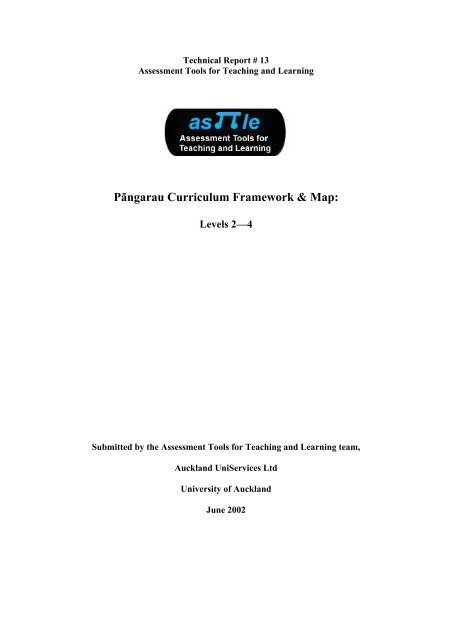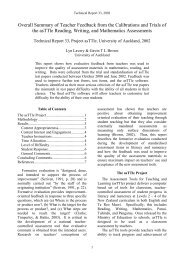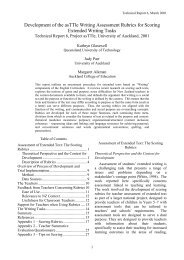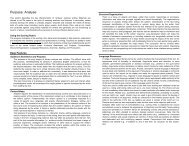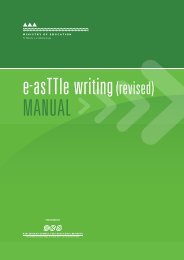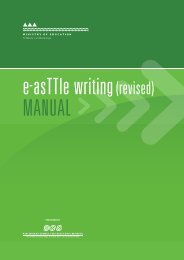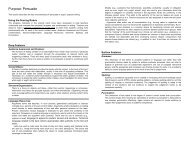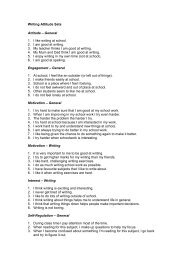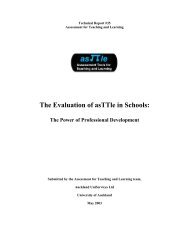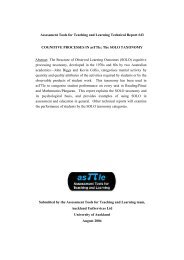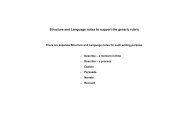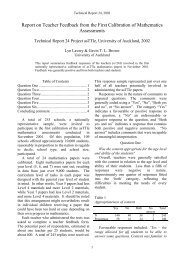Pängarau Curriculum Framework & Map: - e-asTTle
Pängarau Curriculum Framework & Map: - e-asTTle
Pängarau Curriculum Framework & Map: - e-asTTle
Create successful ePaper yourself
Turn your PDF publications into a flip-book with our unique Google optimized e-Paper software.
Technical Report # 13<br />
Assessment Tools for Teaching and Learning<br />
Pängarau <strong>Curriculum</strong> <strong>Framework</strong> & <strong>Map</strong>:<br />
Levels 2—4<br />
Submitted by the Assessment Tools for Teaching and Learning team,<br />
Auckland UniServices Ltd<br />
University of Auckland<br />
June 2002
Pängarau <strong>Curriculum</strong> <strong>Framework</strong> & <strong>Map</strong>:<br />
Levels 2—4<br />
This report details the Level 2-4 <strong>asTTle</strong> Pängarau <strong>Framework</strong> and provides a detailed breakdown of<br />
curriculum achievement objectives by curriculum level. <strong>asTTle</strong> is funded by the Ministry of<br />
Education to Auckland UniServices at the University of Auckland to research and develop an<br />
assessment application for Reading, Writing, Mathematics, Pänui, Pängarau, and Tuhituhi for Years<br />
5-7 (Levels 2-4) for New Zealand schools. We acknowledge this funding, and thank the Ministry of<br />
Education for their continued assistance in the development of this project.<br />
We especially acknowledge Mr. Uenuku Fairhall, principal of Te Kura Kaupapa Māori o Te Koutu,<br />
Rotorua, for outlining his interpretation of how curriculum achievement objectives proceed from<br />
levels 2 to 4, and for providing the pängarau overview map. Uenuku informed us that the Pängarau<br />
<strong>Curriculum</strong> has its genesis in the equivalent English mathematics curriculum and that the<br />
achievement objectives and curriculum frameworks are in most cases near equivalent translations.<br />
He is a recognised expert in the teaching of pāngarau and has been heavily involved its<br />
development.<br />
Dr. Ian Christensen (Massey University) and Mr. Tony Trinick (Auckland College of Education)<br />
provided feedback and critiques on Uenuku’s work. Mr. Peter Keegan has worked closely with the<br />
development team, responding to their ideas, providing details on the <strong>asTTle</strong> development, and<br />
reflecting on how the curriculum map affects the <strong>asTTle</strong> development.<br />
This report is the first in a series of reports on the Pängarau <strong>Curriculum</strong> to which a wide range of<br />
curriculum experts have responded, whom I would also like to thank for readily providing feedback<br />
and analysis.<br />
John Hattie<br />
Project Director, <strong>asTTle</strong><br />
June, 2002<br />
The bibliographic citation for this report is:<br />
Fairhall, U. & Keegan, P. (2002, June). Pängarau curriculum framework and map: Levels 2—4.<br />
<strong>asTTle</strong> Technical Report 13, University of Auckland/Ministry of Education.
Pängarau <strong>Curriculum</strong> <strong>Framework</strong> and <strong>Map</strong><br />
Table of Contents<br />
BACKGROUND .................................................................................................................................2<br />
DEVELOPMENT AND DESCRIPTION OF THE PÄNGARAU CURRICULUM FRAMEWORK<br />
..............................................................................................................................................................4<br />
THE PÄNGARAU CURRICULUM FRAMEWORK........................................................................6<br />
Full Sentence Versions of Achievement Objectives in the Pängarau <strong>Curriculum</strong>.......................6<br />
CHARACTERISTICS OF THE PÄNGARAU CURRICULUM MAP............................................11<br />
CONCLUSION..................................................................................................................................12<br />
REFERENCES...................................................................................................................................12<br />
APPENDIX 1. PÄNGARAU CURRICULUM MAP (LEVELS 2-4) ..............................................13<br />
APPENDIX 2. PÄNGARAU VOCABULARY................................................................................23<br />
The Pängarau <strong>Curriculum</strong> <strong>Framework</strong> and <strong>Map</strong> ultilises insights produced by the mapping<br />
undertaken for mathematic for use in <strong>asTTle</strong> (Ell, 2001). The Pängarau <strong>Curriculum</strong> Statement<br />
(Ministry of Education, 1996) was derived from the Mathematics <strong>Curriculum</strong> Statement (Ministry<br />
of Education, 1992). The Pängarau <strong>Curriculum</strong> contains the same structure, in terms of content<br />
areas, levels, strands, achievement objectives and aims, however, the writers of the Pāngarau<br />
<strong>Curriculum</strong> attempted to include Mäori perspectives on mathematics particularly when suggesting<br />
classroom activities.<br />
There is a paucity of research detailing the differences between the teaching of mathematics and<br />
pängarau in terms of both classroom practice and curriculum implementation. In addition to this,<br />
little is known about what variation exists in the teaching of pängarau throughout the country.<br />
Before detailing the Pängarau <strong>Curriculum</strong> <strong>Framework</strong> it is necessary to provide some background<br />
on the development of the Pängarau <strong>Curriculum</strong> (Ministry of Education, 1996). This document has<br />
provided a unique set of challenges for the team working the on the Pängarau <strong>Curriculum</strong><br />
<strong>Framework</strong>.<br />
1
Fairhall, U & Keegan, P.<br />
Background<br />
Pängarau developments prior to the release of the Pängarau <strong>Curriculum</strong>, were ad-hoc,<br />
uncoordinated and undertaken by range of groups, some of which were sponsored by the Ministry<br />
of Education and its predecessor the Department of Education. As expected in any nascent<br />
development, there was a dearth of resources and those available were poorly disseminated. Many<br />
teachers developed their own resources and literally their own pängarau vocabulary and language<br />
based on the available documentation and input from various groups including other teachers. Two<br />
important aspects of pängarau, variation, and changes in vocabulary and language use have plagued<br />
developments and continue to do so today (see Barton & Fairhall, 1995; Barton, Fairhall, &<br />
Trinick, 1998; Christensen, 1998).<br />
The Pängarau <strong>Curriculum</strong> statement for Mäori medium schools was published in 1996,<br />
following a trial in 1995. The Minister of Education required the curriculum to contain at least<br />
the same achievement objectives as the Mathematics <strong>Curriculum</strong> for mainstream schools.<br />
While this caused some dissension and concern that Mäori knowledge was being ignored, the<br />
passage of time has perhaps resulted in more acceptance that, while the document does not<br />
make Mäori knowledge explicit as part of the curriculum, it does not discount it, and allows<br />
communities to include this where they consider it appropriate, according to the environment,<br />
context, and ability of the school.<br />
Some of the translations in the Pängarau <strong>Curriculum</strong> are not always clear, nor easy to decipher.<br />
This is compounded by the use of technical pängarau language containing a large number of<br />
neologisms, many of which have not appeared in other sources. The Pängarau <strong>Curriculum</strong><br />
statement advocates some changes in existing pängarau terminology. As far as known the new<br />
pāngarau terminology has not yet been adopted by all pängarau teachers. The statement was<br />
written in a neo-meta-language and contained hundreds of new academic and technical Mäori<br />
vocabulary items. The curriculum writers had to create a meta-language, that is a language to<br />
describe language itself (and its associated neologisms) to describe technical aspects of the<br />
curriculum that had never been written about before in Mäori. Not surprisingly the writers also<br />
2
Pängarau <strong>Curriculum</strong> <strong>Framework</strong> and <strong>Map</strong><br />
attempted to standardise some of the existing pängarau vocabulary, in particular the academic<br />
vocabulary (used by students) currently being promoted in Mäori-medium classrooms.<br />
The Pängarau writers worked in isolation from other groups developing Mäori curriculum<br />
statements. This has resulted in some variation in vocabulary between statements; for example,<br />
pängarau uses the term taumata for levels, while te reo Mäori statement uses the term köeke. In<br />
addition, the curriculum statement uses alternative Mäori terms for the same concept, for example,<br />
both tau whakahau kore and tau kewha are terms for irrational numbers. Several terms were used<br />
for practical problems, (e.g., hopanga tüwaenga, höpara wä, rapanga whaitake). The statement (as<br />
were all Mäori curriculum statements) was finally reviewed by Te Taura Whiri, which resulted in<br />
further vocabulary changes, some of which the curriculum writers did not agree with. Te Taura<br />
Whiri published Te Matatiki: Contemporary Mäori Words in 1996. Some of the mathematic terms<br />
in Te Matatiki were different to the pängarau statement, for example, line of symmetry tuaka<br />
hangarite (curriculum), rärangi hangarite (Te Matatiki). The statement has other quirks and<br />
inconsistencies, for example, tauanga ‘statistics’ has 10 taumata ‘levels’; all the other strands have<br />
eight. This inconsistency has still not been explained.<br />
The Pängarau statement, with its meta-language, inconsistencies, and large numbers of new<br />
vocabulary items has not been well received by classroom teachers. It is difficult to read, which<br />
results in teachers referring to the equivalent English mathematics curriculum. Some teachers, who<br />
had been teaching pängarau prior in the introduction of the curriculum, continue to use their own<br />
preferred vocabulary items. More recently trained teachers who have had some background in the<br />
new curriculum statements and have not had exposure to earlier developments may more readily<br />
accept curriculum recommendations. Finally, the Ministry of Education had commissioned Massey<br />
University to review the current curriculum vocabulary. This will result, no doubt, in further<br />
changes.<br />
3
Fairhall, U & Keegan, P.<br />
Development and Description of the Pängarau <strong>Curriculum</strong> <strong>Framework</strong><br />
The <strong>asTTle</strong> Pängarau <strong>Curriculum</strong> <strong>Framework</strong> was based on the <strong>asTTle</strong> Pängarau <strong>Curriculum</strong><br />
Concept <strong>Map</strong> and work undertaken in Mathematics (Ell, 2001; Thomas, Tagg, Holton and Brown,<br />
2002). The map provides an interpretation of achievement objectives and a likely progression from<br />
levels two to four. Although, the achievement objectives in the map are re-written in language and<br />
vocabulary currently favoured by Fairhall (Table 1), this is not considered to be negative. As far as<br />
it is known few teachers have adopted or use the current curriculum language exclusively. Further,<br />
it is possible to clearly map the language of the Table 1 version to that of the current curriculum<br />
(Table 2). It is clear from comparing Table 1 to work undertaken in English that, as the curriculum<br />
statements are very similar, it is logical to expect the frameworks to be similar rather than contain<br />
many major differences.<br />
The <strong>asTTle</strong> Pängarau <strong>Curriculum</strong> <strong>Framework</strong> consists of four major headings (content areas)<br />
rather than eight as in <strong>asTTle</strong> Mathematics. Number and Algebra (Tau and Taurangi) are combined<br />
into one heading. The major reason for this is the current small number of pängarau algebra items<br />
does not permit this to exist as a separate area. Clearly more items in this area need to be<br />
developed, and perhaps, these content areas could be separated in <strong>asTTle</strong> V3. The <strong>asTTle</strong><br />
Mathematics separation of number knowledge and operations and geometric knowledge and<br />
operations could also be replicated in future <strong>asTTle</strong> Pängarau developments provided sufficient<br />
items were available to sustain such fine-grained assessment of Pängarau learning.<br />
A cursory review of early Mäori literature indicates that the quantitative nature of number was<br />
not greatly important, it more often being formulaic (such as in the expression hokowhitu ‘hoko- a<br />
prefix used to signify twenty times the subjoined numeral, whitu ‘seven’, therefore hokowhitu<br />
‘120’, which can also be used when referring to any group of warriors). However, it is suggested<br />
that pattern, and its corollaries of balance and equivalence, permeated Mäori thought and culture,<br />
both social and material – from the reflective gender-determined kinship terms and pronominal<br />
classifications to the intricate designs of köwhaiwhai ‘traditional scroll ornamentation’ and täniko<br />
‘ornamented borders of garments or mats’. Thus, unlike <strong>asTTle</strong> Mathematics where geometry<br />
4
Pängarau <strong>Curriculum</strong> <strong>Framework</strong> and <strong>Map</strong><br />
follows measurement, the alignment of content order in Pängarau, where geometry precedes<br />
measurement, is a reflection of the preeminence of pattern in traditional Mäori culture, including<br />
activities we would now consider to be mathematical.<br />
The knowledge versus application or operations distinction used in <strong>asTTle</strong> mathematics was also<br />
considered to be valid for the Pängarau <strong>Curriculum</strong> <strong>Framework</strong> and this is indicated in the second<br />
level of headings. In many cases objectives can clearly classified as more orientated towards either<br />
knowledge or application. Some objectives, as they are currently written in Mäori, clearly have<br />
both knowledge and application or operation(s). Future versions of <strong>asTTle</strong> will need to consider<br />
whether to re-write or create separate versions for some of the objectives so that these distinctions<br />
are much more evident. At the same time, implementation of such a fine-grained distinction could<br />
be considered when more items are available.<br />
The Pängarau <strong>Curriculum</strong> <strong>Framework</strong>, like the Mathematics <strong>Framework</strong>, contains achievement<br />
objectives derived from the Exemplar Project. These are listed below:<br />
• Make quarter and half turns;<br />
• Know about simple angles including 90º (right angle) and 180º; 30º, 45º and 60º;<br />
• Be able to use a protractor to measure angles to the nearest gradation;<br />
• Assign numerical probability values to simple events;<br />
• Use possible outcomes to assign probabilities;<br />
• Accurately describe aspects of the statistical situation represented by a statistical data<br />
display drawn by others.<br />
These were considered to equally valid for pängarau and successful items were based on these<br />
achievement objectives.<br />
One content area, position (takotoranga), appears in the content area measurement (inenga),<br />
rather than geometry (ähuahanga), as per the <strong>Curriculum</strong>. Clearly, position has components in both<br />
measurement and geometry, yet we accept the argument Ell (2001) put forth for position being a<br />
mathematical way of describing shape and its properties. Thus, position has been moved to<br />
measurement as the majority of <strong>asTTle</strong> mathematics advisors agree that this is its more logical<br />
content area.<br />
5
Fairhall, U & Keegan, P.<br />
The Pängarau <strong>Curriculum</strong> <strong>Framework</strong><br />
Table 1 of the Pängarau <strong>Curriculum</strong> <strong>Framework</strong> and <strong>Map</strong> uses terms currently preferred by the<br />
author. Table 2 follows the official curriculum vocabulary prescriptions. <strong>asTTle</strong> is curriculum<br />
based and therefore it was decided that curriculum preferred terms would be versions used within<br />
the <strong>asTTle</strong> application. Furthermore, most of the more recently trained teachers have had a good<br />
grounding in the Mäori curriculum statements and their implementation. Nevertheless, the<br />
conceptual framework introduced in Table 1 has been adopted in terms of test creation and<br />
performance reporting within the <strong>asTTle</strong> application.<br />
The framework and map detailed in this report has been revised in the light of feedback from<br />
external review and comments from pängarau teachers, especially commenting that the vocabulary<br />
used in the Pängarau <strong>Curriculum</strong> <strong>Framework</strong> should reflect the Pängarau <strong>Curriculum</strong>. In addition<br />
to this, the statements used in the <strong>asTTle</strong> software are given in full sentences in the pages following<br />
the <strong>Framework</strong>. This is to clarify the short forms of Mäori sentences used in the framework. The<br />
vocabulary used in both versions of the <strong>Framework</strong> and their English equivalents are listed in<br />
Appendix 2 by English version alphabetical order.<br />
Full Sentence Versions of Achievement Objectives in the Pängarau <strong>Curriculum</strong><br />
Tau & Taurangi<br />
Mätauranga Tau<br />
Tau oti<br />
Ka pänui, ka whakamärama, ka whakaraupapa i ngä tau oti.<br />
Ka whakamärama i ngä tau töraro.<br />
Ka whakamärama, ka tätari i ngä pü tau oti.<br />
Hautau, Örau, Tau-ä-ira<br />
Ka whakamärama i te tikanga o ngä mati whaiira e toru.<br />
Ka whakaraupapa i ngä mati whaiira e toru.<br />
Paheko Tau<br />
Tau oti<br />
Ka mahara, ka whakamahi i ngä tikanga (meka) täpirihanga, tangohanga,<br />
wehewehe, me te whakarau (whakarea).<br />
Ka täpiri ka tango, ka wehewehe, ka whakarau (whakarea) i ngä tau oti.<br />
Ka whakamahi, ka whakaoti i ngä whärite rärangi mämä.<br />
Ka whakamahi, ka tuhi, ka whakamäori i ngä kauwhata.<br />
Ka tuhi, ka whakaoti i ngä rapanga paki tau oti, i ngä rapanga whakarite tau oti<br />
ki ngä momo paheko e hängai ana.<br />
Whakatau tata<br />
Ka whakatau tata, ka whakamätau i aua whakatau.<br />
Hautau, Örau, Tau-ä-ira<br />
6
Pängarau <strong>Curriculum</strong> <strong>Framework</strong> and <strong>Map</strong><br />
Ka whakamahi, ka kimi, ka whakaatu i ngä hautau ränei, i ngä örau ränei,<br />
i ngä tau-ä-ira ränei mai i te tau oti.<br />
Ka tito, ka whakaoti i ngä rapanga whai tau-ä-ira ränei, whai hautau ränei.<br />
Ka kimi, ka hurihuri i ngä hautau örite ränei, i ngä tau-ä-ira örite ränei,<br />
i ngä örau örite ränei ki ngä momo paheko.<br />
Tautuhi & Raupapa Taurangi<br />
Tauira Raupapa, Tauira Täruarua<br />
Ka kimi, ka whakaroa, ka whakamärama, ka tito ture mö ngä tauira tau,<br />
mö ngä tauira ähua.<br />
Ka whakamahi ture hei matapae i ngä tauira.<br />
Tikanga Taurangi<br />
Ka whakaoti i ngä whärite mämä.<br />
Ka möhio ki te raupapa paheko.<br />
Ähuahanga<br />
Mätauranga/Paheko Ähuahanga<br />
Ähua ahu-2, ähua ahu-3<br />
Ka tautuhi, ka körero i ngä ähuatanga o ngä ähua ahu-2 o ngä ähua ahu-3.<br />
Ka tätai i te paenga i te horahanga i te kïtanga.<br />
Ka körero i ngä momo hangarite.<br />
Koki<br />
Ka möhio ki te huringa-ä-karaka ki te huringa köaro, ki te huringa kotahi hau<br />
hauwhä, ki te huringa kotahi haurua.<br />
Ka möhio ki ngä koki (90°, 180°; 30°, 45°, 60°).<br />
Hangarite & Panoni<br />
Ka körero, ka tuhi, ka hanga i ngä tauira ähuahanga e mau ana i te whakaatatanga,<br />
i te nekehanga, i te huringa.<br />
Ka whakanui, ka whakaiti i te ähua ahu-2.<br />
Koki<br />
Ka whakamahi i ngä huringa.<br />
Ka whakamahi i te ine koki hei ine i ngä koki.<br />
Hanga & Tuhi<br />
Ka tautuhi, ka körero, ka hanga, ka whakatauira, ka tuhi i ngä ähua ahu-2,<br />
i ngä ahu-3.<br />
Ka tuhi raumata hei hanga i ngä matarau mämä.<br />
Inenga<br />
Inenga<br />
Ngahuru<br />
Ka ineine, ka whakatau tata i te ine roa, i te papatipu, i te rörahi, i te horahanga,<br />
i te kïtanga, i te mahana.<br />
Ka ineine, ka möhio ki te inenga äwhata ki te tauwhata tata rawa.<br />
Wä<br />
Ka whai, ka huri i te wä ringarua, i te wämati.<br />
Ka tätai wä ki te karaka 12 ngä häora, ki te karaka e 24 ngä häora.<br />
Ka möhio ki ngä inenga wä.<br />
Ka whai, ka whakamäori, ka hanga i ngä körero äwhata, i ngä wätaka,<br />
i ngä tütohi wä.<br />
Takotoranga<br />
Ka körero ka whakamäori, ka tuhi, ka tautuhi i te takotoranga ki te ahunga,<br />
ki te tawhiti, ki te mahere äwhata, ki te taunga tukutuku.<br />
7
Fairhall, U & Keegan, P.<br />
Tauanga<br />
Tüponotanga<br />
Whakamätau<br />
Ka whakariterite, ka whakaraupapa, ka kohikohi i ngä raraunga whaihua.<br />
Ka matapae i tëtahi päpono ki te tüponotanga.<br />
Whakatauira<br />
Ka kimi huarahi nahanaha hei tatau päpono. Ka whakamahi hoahoa<br />
hei whakaatu päpono.<br />
Ka whakamahi i te hoahoa räkau hei whakaatu i te päpono.<br />
Ka whakarite ka matapae i ngä tüponotanga i ngä auau o ngä päpono.<br />
Ka whakatau tata i ngä auau o ngä päpono, ka tuhi ai ki te äwhata.<br />
Tauanga<br />
Höpara<br />
Ka whakarite höpara. Ka kimi raraunga.<br />
Ka kohikohi, ka whakaari raraunga.<br />
Ka köwhiri, ka whakaari i te raraunga.<br />
Ka köwhiri, ka hanga whakaaturanga raraunga.<br />
Ka tuhi, ka whakamahi i ngä äwhata mämä.<br />
Whakamäori<br />
Ka körero, ka tuhi pürongo mö ngä ähuatanga köhure o ngä whakaari raraunga.<br />
Ka whakarite, ka whakawä i ngä whakatau mö te whakamäoritanga o ngä<br />
raraunga.<br />
8
Table 1. Pängarau <strong>Curriculum</strong> <strong>Framework</strong>, First Version (levels 2-4)<br />
Mätauranga<br />
Tau<br />
Tau oti<br />
• Whai,<br />
whakamärama,<br />
Whakaraupapa tau<br />
oti.<br />
• Whakamärama tau<br />
töraro<br />
• Whakamärama,<br />
tätai i ngä pü tau oti<br />
Tau wähi,<br />
ärautanga, tauä-ira<br />
• Whakamärama<br />
tikanga mati &<br />
Whakaraupapa tau e<br />
toru ngä mati-ä-ira<br />
Tau & Tauira Toi Ähua Inenga Tätaritari<br />
Paheko Tau Tauira Tau Mätauranga<br />
Ähua<br />
Tau oti<br />
• Mahara,<br />
whakamahi tikanga<br />
täpiripiri,tangotango,<br />
whakarau<br />
• Täpiri, tangotango,<br />
whakarau,wehewehe<br />
tau oti<br />
• Whakamahi,<br />
whakaoti<br />
whakaritenga<br />
hangatahi<br />
• Whakamahi,<br />
hoahoa, whakamäori<br />
kauwhata<br />
• Tito, whakaoti paki<br />
raparapa, rapanga<br />
kikokiko mau tau oti<br />
e whiri paheko ai<br />
Whakapae<br />
• Whakapae,<br />
whakamätau otinga<br />
Tauwähi &<br />
Tau-ä-ira<br />
• Whakahuri<br />
wähanga rahinga hei<br />
tauwähi, tau-ä-ira,<br />
ärautanga<br />
• Whakahurihuri i<br />
ngä tauwähi haurite,<br />
tau-ä-ira, ärautanga<br />
• Tito, whakaoti<br />
rapanga whai<br />
tauwähi, tau-ä-ira,<br />
ärautanga<br />
Tauira<br />
hätepetepe,<br />
täruarua<br />
• Kimi, whakaroa,<br />
körero, tito ture mö<br />
ngä tauira tau, tauira<br />
ähua<br />
• Whakamahi ture<br />
hei matapae ture<br />
Tikanga tau<br />
• Whakaoti<br />
whäritenga<br />
hangatahi<br />
• Möhio ki te<br />
raupapa paheko<br />
Ähua ahu-2, -3<br />
• Tautuhi ähua, ka<br />
körero ai i ngä<br />
ähuatanga ahu-2, -3<br />
• Tätai takanga,<br />
horahanga, kïtanga<br />
• Körero i ngä momo<br />
hangarite<br />
Koki<br />
• Möhio ki ngä<br />
huringa-ä-karaka,<br />
hurituatanga kia<br />
kotahi whätanga,<br />
rautanga<br />
• Möhio ki ngä koki<br />
mäori (90°, 180°;<br />
30°, 45°, 60°)<br />
Hanga<br />
Ähua<br />
Hangarite &<br />
Panoni<br />
• Körero, hoahoa,<br />
hanga tauira ähua ki<br />
te täruarua, hurihuri,<br />
whakaata<br />
• Whakarahi,<br />
whakaiti ähua<br />
ahu-2<br />
Koki<br />
• Huri-ä-karaka,<br />
huritua kia kotahi<br />
whätanga, ruatanga<br />
• Whakamahi täputu<br />
hei ine koki<br />
Hanga &<br />
Hoahoa<br />
• Tautuhi, körero,<br />
hanga, whakatauira,<br />
hoahoa ähua<br />
ahu-2, -3<br />
• Hoahoa papakahu<br />
hei hanga matarau<br />
hangatahi<br />
Inenga Tüponopono Tätaritari<br />
Wähi<br />
• Körero,<br />
whakamäori, tuhi,<br />
tautuhi takotoranga<br />
ki ngä ahunga,<br />
hoahoa ahurite,<br />
taunga tukutuku<br />
Tämita<br />
• Ineine, whakapae<br />
ine roa, taumaha,<br />
horahanga, kïtanga,<br />
kapinga, päkiri<br />
• Ineine, whai<br />
inenga, whatarau ki<br />
te tauputu tata rawa<br />
Wä<br />
• Whai,<br />
whakawhitiwhiti i te<br />
wä ringarua, matirau<br />
• Tätai wä ki te<br />
karaka 12, 24-häora<br />
• Möhio ki ngä<br />
tikanga wä<br />
• Whai,<br />
whakamäori, hanga<br />
körero, whatarau,<br />
wätaka, papatohu<br />
wä<br />
Whakamätau<br />
• Whakariterite,<br />
whakaraupapa raraunga<br />
• Matapae putanga ki<br />
te tüponotanga<br />
Whakatauira<br />
• Kimi haurahi<br />
nahanaha hei tatau<br />
putanga<br />
• Whakamahi hoahoa<br />
mangarau hei kimi<br />
putanga<br />
• Whakapae<br />
rauputanga, ka tuhi ai<br />
ki te whatarau<br />
• Whakarite ritenga tau<br />
ki te tüponotanga<br />
•Whakamahi putanga<br />
hei tätai tüponotanga<br />
Höpara<br />
• Whakarite höpara<br />
• Kohikohi raraunga<br />
• Köwhiri, hanga<br />
whakaaringa<br />
raraunga<br />
• Hoahoa,<br />
whakamahi<br />
whatarau hangatahi<br />
Whakamäori<br />
• Körero, pürongo i<br />
ngä ähuatanga<br />
köhure o ngä<br />
whakaaringa<br />
raraunga<br />
• Whakarite,<br />
whakawä i ngä<br />
whakatau,<br />
whakamäoritanga<br />
raraunga
Fairhall, U & Keegan, P.<br />
Table 2. Pängarau <strong>Curriculum</strong> <strong>Framework</strong>, Final Version (levels 2-4)<br />
Tau & Taurangi Ähuahanga Inenga Tauanga<br />
Mätauranga Tau Paheko Tau Tautuhi &<br />
Raupapa<br />
Taurangi<br />
Tau oti<br />
• Whai,<br />
whakamärama,<br />
whakaraupapa tau<br />
oti<br />
• Whakamärama tau<br />
oti töraro<br />
• Whakamärama,<br />
tätari i ngä pü tau oti<br />
Hautau, Örau,<br />
Tau-ä-ira<br />
• Whakamärama<br />
tikanga mati &<br />
Whakaraupapa tau e<br />
toru ngä mati<br />
whaiira<br />
Tau oti<br />
• Mahara,<br />
whakamahi tikanga<br />
(meka) täpiritanga,<br />
tangohanga,whakarau<br />
• Täpiri, tango,<br />
whakarau,wehewehe<br />
tau oti<br />
• Whakamahi,<br />
whakaoti<br />
whärite rärangi<br />
• Whakamahi,<br />
tuhi, whakamäori<br />
kauwhata<br />
• Tito, whakaoti<br />
rapanga paki,<br />
rapanga whakarite<br />
mau tau oti<br />
e whiri paheko ai<br />
Whakatau tata<br />
• Whakatau tata,<br />
whakamätau otinga<br />
Hautau, Örau,<br />
& Tau-ä-ira<br />
• Ka huri, whakamahi<br />
tau oti hei hautau,<br />
tau-ä-ira, örau<br />
• Tito, whakaoti<br />
rapanga whai hautau,<br />
tau-ä-ira, örau<br />
• Huri i ngä hautau<br />
örite, tau-ä-ira, örau<br />
Tauira<br />
-Raupapa,<br />
-Täruarua<br />
• Kimi, whakaroa,<br />
whakamärama, tito<br />
ture mö ngä tauira<br />
tau, tauira ähua<br />
• Whakamahi ture<br />
hei matapae tauira<br />
Tikanga<br />
Taurangi<br />
• Whakaoti whärite<br />
mämä<br />
• Möhio ki te<br />
raupapa paheko<br />
Mätauranga/Paheko<br />
Ähuahanga<br />
Ähua ahu-2, -3<br />
• Tautuhi ähua, ka<br />
körero ai i ngä<br />
ähuatanga ahu-2, -3<br />
• Tätai paenga,<br />
horahanga, kïtanga<br />
• Körero i ngä momo<br />
hangarite<br />
Koki<br />
• Möhio ki ngä<br />
huringa-ä-karaka,<br />
huringa köaro, kia<br />
kotahi hauwhä,<br />
kotaihi haurua<br />
• Möhio ki ngä koki<br />
(90°, 180°, 30°, 45°,<br />
60°)<br />
Hangarite &<br />
Panoni<br />
• Körero, tuhi,<br />
hanga tauira<br />
ähuahanga ki te<br />
nekehanga, huringa,<br />
whakaatatanga<br />
• Whakarahi,<br />
whakaiti ähua ahu-2<br />
Koki<br />
• Whakamahi huri<br />
• Whakamahi ine<br />
koki hei ine koki<br />
Hanga & Tuhi<br />
• Tautuhi, körero,<br />
hanga, whakatauira,<br />
tuhi ähua ahu-2, -3<br />
• Tuhi raumata hei<br />
hanga matarau<br />
mämä<br />
Inenga Tüponotanga Tauanga<br />
Ngahuru<br />
• Ineine, whakatau<br />
tata ine roa<br />
papatipu, rörahi,<br />
horahanga, kïtanga,<br />
mahana<br />
• Ineine, möhio ki te<br />
inenga äwhata ki te<br />
tauwhata tata rawa<br />
Wä<br />
• Whai, Huri i te wä<br />
ringarua, wämati<br />
• Tätai wä ki te<br />
karaka 12 häora, 24<br />
häora<br />
• Möhio ki ngä<br />
inenga wä<br />
• Whai,<br />
whakamäori, hanga<br />
körero äwhata,<br />
wätaka, tütohi wä<br />
Takotoranga<br />
• Körero,<br />
whakamäori, tuhi,<br />
tautuhi takotoranga<br />
ki ngä ahunga,<br />
tawhiti, mahere<br />
äwhata, taunga<br />
tukutuku<br />
Whakamätau<br />
• Whakariterite,<br />
whakaraupapa,<br />
kohikohi raraunga<br />
whaihua<br />
• Matapae päpono ki te<br />
tüponotanga<br />
Whakatauira<br />
• Kimi haurahi<br />
nahanaha hei tatau<br />
päpono<br />
Whakamahi hoahoa<br />
räkau hei whakaatu<br />
päpono<br />
• Whakarite, matapae<br />
tüponotanga me ngä<br />
auau o ngä päpono<br />
• Whakatau tata auau o<br />
ngä päpono, ka tuhi ai<br />
ki te äwhata<br />
Höpara<br />
• Whakarite höpara<br />
• Kohikohi raraunga<br />
• Köwhiri, whakaari<br />
raraunga<br />
• Köwhiri, hanga<br />
whakaaturanga<br />
raraunga<br />
• Tuhi, whakamahi<br />
äwhata mämä<br />
Whakamäori<br />
• Körero, pürongo i<br />
ngä ähuatanga<br />
köhure o ngä<br />
whakaari raraunga<br />
• Whakarite,<br />
whakawä i ngä<br />
whakatau mö te<br />
whakamäoritanga<br />
raraunga<br />
10
Characteristics of the Pängarau <strong>Curriculum</strong> <strong>Map</strong><br />
The Pängarau <strong>Curriculum</strong> <strong>Map</strong> is given in Appendix 1. The map was completed first and used<br />
to inform the development of the Pāngarau <strong>Curriculum</strong> <strong>Framework</strong>.<br />
The major headings of the map are:<br />
• tikanga tau ‘number properties/knowledge’,<br />
• tätaitai/whakapae ‘number and algebraic operations/estimate’,<br />
• ineine tämita ‘metric measurement’,<br />
• pahurenga wä ‘time’,<br />
• tauira ‘pattern’,<br />
• āhua & wähi ‘shape and place’,<br />
• tüponopono ‘probability’, and<br />
• tätaritari ‘statistics’.<br />
Achievement objectives, often re-rewritten in simplified language, appear under the major<br />
headings by year level. The arrows indicate a possible progression of achievement objectives (or<br />
sometimes a group of achievement objectives) over curriculum levels and which are related. These<br />
progressions are not always continous and sometimes one objective may link to a number of<br />
objectives at a higher level or groups of objectives may have some overlap or relationship. Other<br />
objectives are given in isolation and not all proceed to higher levels.<br />
Each achievement objective’s curriculum content area origin is indicated by the following codes:<br />
T Tau ‘number’<br />
I Ine ‘measurement’<br />
A Ähuahanga ‘geometry’<br />
TR Taurangi ‘algebra’<br />
TT Tauanga ‘statistics’<br />
The number following the abbreviation indicates taumata ‘level’ and the final number indicates<br />
the actual achievement object number as listed in the curriculum, (i.e. (T II−3) indicates the third<br />
level 2 number objective). An asterisk indicates an achievement objective derived from another<br />
already appearing in the map.<br />
11
Fairhall, U & Keegan, P.<br />
Conclusion<br />
The <strong>asTTle</strong> pängarau curriculum framework and map is a Māori language based framework that<br />
supports the teaching of pāngarau and provides a strong basis for the development of <strong>asTTle</strong><br />
pāngarau assessment items and reporting of student achievement. Although not identical to the<br />
Pāngarau <strong>Curriculum</strong>, it is clearly derived from it and takes advantage of professional reflection and<br />
research on mathematics education conducted in the last decade. Additional achievement<br />
objectives can be readily accommodated, as it is clear that the Pāngarau <strong>Curriculum</strong> does not cover<br />
all activities currently undertaken in pāngarau classrooms. The framework uses pāngarau<br />
curriculum vocabulary and can be updated if future developments result in changes or modifications<br />
to existing terminology.<br />
References<br />
Barton, B. & Fairhall, U. (1995) Is mathematics a trojan horse? In B. Barton & U. Fairhall (Eds.),<br />
Mathematics in Mäori education. University of Auckland: School of Education.<br />
Barton, B., Fairhall, U. & Trinick, T. (1998). Issues in the development of a Mäori mathematics<br />
register. For the learning of mathematics 18(1), 3–9.<br />
Christensen, I. (1996). Mäori mathematics. He Pukenga Körero 1(2), 42–47.<br />
Ell, F. (2001). Mathematics in the New Zealand <strong>Curriculum</strong> – a concept map of the curriculum<br />
document. Technical Report 11, Project <strong>asTTle</strong>, University of Auckland.<br />
Mäori Language Commission: Te Taura Whiri i te Reo Mäori. (1996). Te Matatiki:<br />
Contemporary Mäori words. Auckland: Oxford University Press.<br />
Ministry of Education. (1996). Pängarau i roto i te marautanga o Aotearoa. Te Whanganui ä Tara:<br />
Te Pou Taki Körero.<br />
Ministry of Education. (1992). Mathematics in the New Zealand <strong>Curriculum</strong>. Wellington:<br />
Learning Media.<br />
Thomas, G., Tagg, A., Holton, D., & Brown, G. T. L. (2002). Numeracy Item Signature Study: A<br />
Theoretically Derived Basis. Technical Report 25, Project <strong>asTTle</strong>, University of Auckland.<br />
12
Appendix 1. Pängarau <strong>Curriculum</strong> <strong>Map</strong> (levels 2-4)<br />
TIKANGA TAU<br />
Kaupapa Taumata 2 Taumata 3 Taumata 4<br />
Ka whai i ngä tauoti mati 2, 3.<br />
(T II−1)<br />
Ka whai i ngä tauoti mati katoa.<br />
(T III−1*)<br />
T<br />
A<br />
U<br />
O<br />
T<br />
I<br />
Ka whakamärama i ngä mati o<br />
ngä tauoti mati 2, 3. (T II−2)<br />
Ka whakaraupapa i ngä tauoti<br />
e toru (T II−3)<br />
Ka whakamärama i ngä mati<br />
tauoti katoa. (T III−1)<br />
Ka whakaraupapa i ngä tauoti.<br />
(T III−3*)<br />
Ka whakamärama i ngä tau<br />
töraro. (T IV−1)<br />
Ka whakamärama, ka tätai i ngä<br />
pütanga tauoti. (T IV−2)<br />
13
Fairhall, U & Keegan, P.<br />
T<br />
T A<br />
A U<br />
U |<br />
W Ä<br />
Ä |<br />
H I<br />
I R<br />
A<br />
Ka whakamahi tauwähi<br />
( 2<br />
1 , 3<br />
1 , 4<br />
1 , 5<br />
1 ) i ngä pakipaki<br />
raparapa. (T II−5)<br />
Ka whakaatu i te rahinga moni<br />
ki ngä hononga tära, kapa.<br />
(T III−3)<br />
Ka whakaoti raparapa kikokiko<br />
e kimi ai i ngä wähanga tauoti,<br />
tau−ä−ira. (T III−7)<br />
Ka whakamärama i ngä mati o<br />
ngä tau−ä−ira, tae noa ki te ira<br />
tuatoru. (T III−2)<br />
Ka whakaraupapa i ngä<br />
tau−ä−ira e toru nei ngä<br />
mati−ä−ira. (T III−3)<br />
Ka tuhi ngä wähanga rahinga<br />
hei tauwähi, ärau. (T IV−6)<br />
Ka kimi i ngä tauwähi haurite.<br />
(T IV−3)<br />
Ka whakahuri i te tauwähi hei<br />
tau−ä−ira, i te tau−ä−ira hei<br />
tauwähi. (T IV−4)<br />
Ka whakahuri i te tau−ä−ira hei<br />
ärau, i te ärau hei tau−ä−ira.<br />
(T IV−5)<br />
14
TÄTAITAI / WHAKAPAE I<br />
Kaupapa Taumata 2 Taumata 3 Taumata 4<br />
Ka whakaoti−ä−hinengaro i ngä<br />
mahi täpiripiri, tangotango<br />
(T II−8)<br />
Ka mahara ki ngä tikanga<br />
täpiripiri, tangotango. (T II−7)<br />
P<br />
A<br />
H<br />
E<br />
K<br />
O<br />
Ka whakaatu i te möhio ki ngä<br />
tikanga whakarau. (T II−9)<br />
Ka möhio ki te täpiripiri,<br />
tangotango, whakarau,<br />
wehewehe tauoti. (T II−10*)<br />
Ka mahara ki ngä tikanga<br />
Whakarau. (T III−5)<br />
Ka täpiripiri, tangotango,<br />
whakarau, wehewehe tauoti,<br />
tau–ä–ira. (T III−6*)<br />
Ka whakamärama i ngä hätepe<br />
täpiripiri, tangotango, whakarau<br />
tika. (T IV−10)<br />
Ka whakaatu i te möhio ki te<br />
raupapa paheko. (T IV−11)<br />
Ka whakarite toenga moni.<br />
(I II−2)<br />
Ka whakamahi i ngä tohu tätai:<br />
=, . (TR II−3)<br />
Ka whakaoti, whäritenga pënei i<br />
te r + 15 = 39. (TR III−5)<br />
Ka whakaoti whäritenga pënei i<br />
te 5 r + 3 = 23. (TR IV−5)<br />
15
Fairhall, U & Keegan, P.<br />
TÄTAITAI / WHAKAPAE II<br />
Kaupapa Taumata 2 Taumata 3 Taumata 4<br />
W R<br />
H A<br />
A P<br />
K A<br />
A R<br />
O A<br />
T P<br />
I A<br />
Ka tuhi, ka whakaoti rapanga<br />
whakarite (T II−4)<br />
Ka whakapae, ka whakamätau<br />
otinga. (T II−6)<br />
Ka tito ka whakaoti paki<br />
raparapa, tauoti e mau ai<br />
• te paheko kotahi; (T II−10)<br />
• te paheko hei whiri: (T II−1)<br />
• ngä tauwähi: 2<br />
1 , 3<br />
1 ,<br />
4<br />
1 , 5<br />
1 .<br />
(T II−5)<br />
Ka whakapae, ka whakamätau<br />
otinga (T III−4)<br />
Ka tito, ka whakaoti rapanga<br />
whai tauoti, tau-ä-ira e whiri ai i<br />
(t)ëtahi o ngä paheko. (T III−6)<br />
Ka whakaoti rapanga kikokiko<br />
e kimi ai i ngä wähanga tauoti,<br />
tau-ä-ira. (T III−7)<br />
Ka tautuhi i te ture mö te whakaoti<br />
raparapa kikokiko (TR III−3)<br />
Ka whakapae, ka whakamätau i<br />
ngä otinga. (T IV−7)<br />
Ka tito, ka whakaoti raparapa wha i<br />
whakarauhanga, wehenga tau-ä-ira.<br />
(T IV−8)<br />
Ka kimi i te tauwähi, ärau rahinga.<br />
(T IV−9)<br />
Ka kimi, ka parahau tauira kupu e<br />
whakatau ana i te ähuatanga mahi<br />
noa. (TR IV−4)<br />
16
INEINE TÄMITA<br />
Kaupapa Taumata 2 Taumata 3 Taumata 4<br />
M<br />
I A<br />
N H<br />
E I<br />
I<br />
N N<br />
E O<br />
A<br />
Ka whai mahi ineine, me ngä<br />
inenga tämita o te:<br />
• roa,<br />
• taumaha,<br />
• rahi (I II−1)<br />
Ka whakatau i te möhio ki ngä<br />
inenga matua:<br />
• roa<br />
• taumaha<br />
• horahanga<br />
• kïtanga<br />
• päkiri (I III−1)<br />
Ka whai mahi ineine, me ngä<br />
inenga, whatarau huhua (I III−2)<br />
Ka whai mahi ineine e uru ai te<br />
whai whatarau ki te tauputu tata<br />
rawa. (T IV−1)<br />
PAHURENGA WÄ<br />
Kaupapa Taumata 2 Taumata 3 Taumata 4<br />
I<br />
N<br />
E W<br />
I Ä<br />
N<br />
E<br />
I<br />
Ka whai i te wä, ka möhio ki<br />
ngä inenga wä:<br />
• ringaringa<br />
• mati. (I II−4)<br />
Ka whai i te wä, ka möhio ki<br />
ngä inenga wä – meneti, häora,<br />
rä wiki, marama, tau. (I II−4)<br />
Ka whakawhitiwhiti i te wä<br />
ringaringa me te wä matirau.<br />
(I III−4)<br />
Ka whai, ka whakamäori i ngä<br />
körero mau wä. (I III−3)<br />
Ka mahi tätainga wä, me te<br />
karaka 24−häora. (I IV−5)<br />
Ka whai, ka hanga whatarau,<br />
wätaka, papatohu. ( I IV−3)<br />
17
Fairhall, U & Keegan, P.<br />
TAUIRA<br />
Kaupapa Taumata 2 Taumata 3 Taumata 4<br />
T<br />
A T<br />
U A<br />
I U<br />
R<br />
A<br />
Ka whakaroa tauira raupapa, ka<br />
whakarite ture ai. (TR II−1)<br />
Ka whakamahi kauwhata hei<br />
whakaatu i ngä pänga. (TR II−2)<br />
Ka körero i ngä tauira tau,<br />
mokowä hätepe. (TR III−1)<br />
Ka tito ka whakamahi ture e puta<br />
ai te tauira raupapa. (TR III−2)<br />
Ka whakamahi kauwhata hei<br />
whakaatu i ngä pänga tau, pänga<br />
noa. (TR III−4)<br />
Ka kimi ture hei körero i ngä<br />
haunga hätepe tau. (TR IV−1)<br />
Ka whakamahi ture hei matapae.<br />
(TR IV−2)<br />
Ka tuhi, ka whakamäori i ngä<br />
kauwhata whakaatu ähuatanga<br />
mäori. (TR IV−3)<br />
P H<br />
A A<br />
N N<br />
O G<br />
N A<br />
I R<br />
I<br />
T<br />
E<br />
Ka huri-ä-karaka, ka huritua.<br />
(A II−4)<br />
Ka hanga, ka whakaahua i ngä<br />
tauira:<br />
• ähua täruarua<br />
• hangarite hurihuri<br />
• whakataata. (A II−3)<br />
Ka hoahoa, ka hanga i te tauira:<br />
• täruarua<br />
• hurihuri<br />
• whakaataata. (A III−7)<br />
Ka körero i ngä tauira mau:<br />
• hangarite hurihuri<br />
• hangarite whakaata<br />
• nekenekehanga. (A III−6)<br />
Ka whakarahi ahurite i runga i<br />
te tukutuku. (A III−8)<br />
Ka whakauru i ngä tikanga<br />
hangarite o te taparau rite.<br />
(A IV−6)<br />
Ka körero i te hangarite<br />
whakataata, hurihuri o te ähua<br />
taonga. (A IV−7)<br />
Ka whakarahi, ka whakaiti ähua<br />
ahu-2, ka tautuhi ai i ngä<br />
ähuatanga pümau. (A IV−8)<br />
18
ÄHUA & WÄHI<br />
Kaupapa Taumata 2 Taumata 3 Taumata 4<br />
Ä<br />
H<br />
U<br />
A<br />
Ka hanga, ka tautuhi, ka körero<br />
i ngä ähua mäori:<br />
• ki töna reo<br />
• ki te reo toi ähua. (A II−8)<br />
Ka körero i ngä mea ahu-2, -3<br />
ki te reo toi ähua. (A III−1)<br />
Ka whakatauira, körero i ngä<br />
mea ahu-3 i whakaahuatia.<br />
(A III−3)<br />
Ka tuhi tapatoru, porohita ki<br />
ngä taputapu tika. (A IV−1)<br />
Ka tätai (ki ngä inenga roanga):<br />
• hängai, tapatoru<br />
• horahanga tapawhä hängai<br />
• kïtanga porowhä. (I IV−2)<br />
Ka hanga tauira papatupu ki ngä<br />
hoahoa o runga, mua, muri, ngä<br />
taha. (A IV−3)<br />
Ka whakaahua o ngä mea ahu-3<br />
ngäwari. (A III−4)<br />
Ka tuhi hoahoa o ngä taonga I<br />
hanga ki te porowhä. (A IV−4)<br />
Ka hoahoa, ka hanga pouaka<br />
e ai ki ngä tohutohu. (A III−2)<br />
Ka hoahoa papakahu hei hanga<br />
matarau ngäwari e ai ki ngä<br />
tohutohu. (A IV−2)<br />
W<br />
Ä<br />
H<br />
I<br />
Ka körero, ka whakamäori i te<br />
takotoranga. (A II−2)<br />
Ka whakaahua, whakamäori i<br />
ngä hoahoa ahurite. (A III−5)<br />
Ka tautuhi takotoranga ki ngä<br />
ahunga, taunga tukutuku.<br />
(A IV−5)<br />
19
Fairhall, U & Keegan, P.<br />
TÜPONOPONO<br />
Kaupapa Taumata 2 Taumata 3 Taumata 4<br />
T<br />
Ü<br />
P<br />
O<br />
N<br />
O<br />
Ka whakariterite putanga, ka<br />
whakaraupapa ki te<br />
tüponotanga. (TT II−4)<br />
Ka kimi huarahi nahanaha hei<br />
tatau putanga. (TT III−5)<br />
Ka matapae putanga ki täna i<br />
kitekite ai. (TT III−6)<br />
Ka whakamahi hoahoa mangarau<br />
hei kimi putanga. (TT IV−9)<br />
Ka whakapae i te rauputanga,<br />
ka tuhi ai ki runga i te whatarau .<br />
(TT IV−8)<br />
20
TÄTARITARI I<br />
Kaupapa Taumata 2 Taumata 3 Taumata 4<br />
H<br />
Ö<br />
P<br />
A<br />
R<br />
A<br />
Ka kohikohi, ka whakaatu<br />
raraunga ähua, tauoti ki te<br />
• kauwhata ähua<br />
• papa tatau<br />
• kauwhata poupou. (TT II−1)<br />
Ka kohikohi, ka whakaatu<br />
raraunga tau mowaho ki te:<br />
• kauwhata rau–tö<br />
• kauwhata ira<br />
• kauwhata tähei. (TT III–2)<br />
Ka köwhiri, ka hanga whakaaringa<br />
raraunga hei whakaatu ähuatanga<br />
täpua:<br />
• papatau<br />
• kauwhata poupou<br />
• kauwhata pouhere. (TT IV–2)<br />
Ka kohikohi, ka whakaatu raraunga<br />
raupapa houanga. (TT IV−4)<br />
Ka hoahoa, ka whakamahi whatarau<br />
ngäwari hei ine raraunga kounga<br />
kounga. (I IV−4)<br />
Ka whakarite höpara täpaetanga<br />
körero. (TT III−1)<br />
Ka whakamahi ture hei matapae<br />
(TR IV−2)<br />
Ka kohikohi raraunga hängaingai.<br />
(TT IV−2)<br />
21
Fairhall, U & Keegan, P.<br />
TÄTARITARI II<br />
Kaupapa Taumata 2 Taumata 3 Taumata 4<br />
W<br />
H<br />
A<br />
K<br />
A<br />
M<br />
Ä<br />
O<br />
R<br />
I<br />
Ka körero atu i äna ake<br />
whakaaringa raraunga.<br />
(TT II−2)<br />
Ka körero atu i te hapanga o te<br />
whakaaringa raraunga a tëtahi<br />
atu. (TT II−3)<br />
Ka whakamärama i ngä<br />
ähuatanga köhure<br />
• mowaho<br />
• räpoi<br />
i äna, i a ëtahi atu whakaaringa<br />
raraunga. (TT III−3)<br />
Ka whakaputa whakaaro<br />
whaitake mö te täpaetanga<br />
körero. (TT III−4)<br />
Ka whakamärama i ngä<br />
ähuatanga köhure o te whakaaringa<br />
raraunga:<br />
• mowaho<br />
• räpoi<br />
• hanga tuaringa. (TT IV−5)<br />
Ka whakawä i ngä<br />
whakamäramatanga a ëtahi atu.<br />
(TT IV−6)<br />
Ka täpae whakaaro i ngä pänga<br />
mahi e hängai ai ki ngä tukunga<br />
iho. (TT IV−7)<br />
22
Appendix 2. Pängarau Vocabulary<br />
Mathematics Term <strong>Curriculum</strong> Equivalent First Version Terminology<br />
2D & 3D shape ähua ahu-2, -3<br />
algebra<br />
taurangi<br />
analogue time wä ringarua<br />
angle<br />
koki<br />
area<br />
horahanga<br />
bearings<br />
taunga<br />
capacity kïtanga kapinga<br />
construct<br />
hanga/waihanga<br />
decimal<br />
tau-ä-ira<br />
decimal place mati whaiira mati-ä-ira<br />
digit<br />
mati<br />
digital time wämati wä matirau<br />
direction<br />
ahunga<br />
display (n.) whakaari whakaaringa<br />
distance<br />
tawhiti<br />
distinctive<br />
köhure<br />
draw tuhi hoahoa<br />
equivalent taurite haurite<br />
estimate whakatau tata whakapae<br />
evaluate (not assess) tätari tätai<br />
event päpono putanga<br />
fraction hautau/hautanga tau wähi<br />
frequency of appearance<br />
rauputanga<br />
geometry ähuahanga toi ähua<br />
gradation<br />
tauputu<br />
grid<br />
tukutuku<br />
identify<br />
tautuhi<br />
interpret<br />
whakamäori<br />
investigate whiriwhiri/höpara höpara<br />
length<br />
roa (-nga)<br />
linear equation whärite rärangi whäritenga rärangi<br />
mass papatipu taumaha<br />
measurement inenga ineine<br />
metric ngahuru tämita<br />
model (v.)<br />
whakatauira<br />
net (geometry) raumata papakahu<br />
number tau tau/nama<br />
outcome hua putanga<br />
operate (with) whawhe hanga<br />
operation<br />
paheko<br />
order<br />
raupapa<br />
pattern tauira hoahoa<br />
percent örau ärautanga<br />
perimeter paenga takanga<br />
power (of a number) pü<br />
position takotoranga wähi<br />
practical problems rapanga whärite rapanga kikokiko<br />
23
Fairhall, U & Keegan, P.<br />
predict<br />
matapae<br />
probability tüponotanga tüponopono<br />
problem<br />
rapanga<br />
problem solving whakaoti rapanga<br />
properties ähuatanga ähuatanga/tikanga<br />
protractor ine koki täputu<br />
repeating<br />
täruarua<br />
scale äwhata whatarau<br />
scale map mahere äwhata hoahoa ahurite<br />
sequence/sequential raupapa hätepetepe<br />
simple equation whärite mämä whäritenga hangatahi<br />
solve<br />
whakaoti<br />
spatial pattern tauira mokowä tauira ähua<br />
statistics tauanga tätaritari<br />
symmetry<br />
hangarite<br />
temperature mahana päkiri<br />
time<br />
wä<br />
transformation panoni<br />
translation (geo.) nekehanga<br />
trial (v.)<br />
whakamätau<br />
tree diagram hoahoa räkau mangarau<br />
understand orotau/arotau märama (ki)<br />
use<br />
whakamahi<br />
volume<br />
rörahi<br />
whole number tau oti tauoti<br />
24


